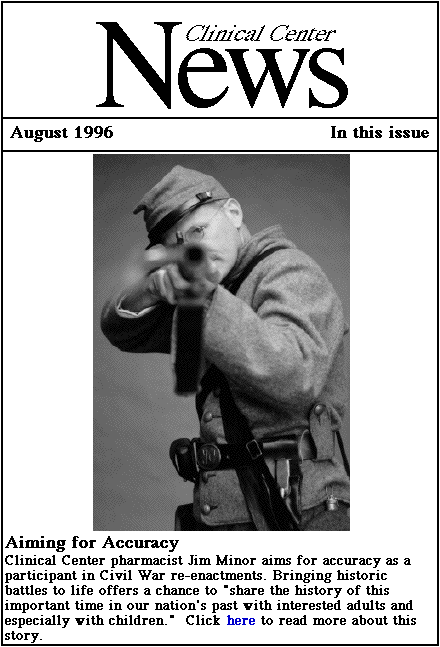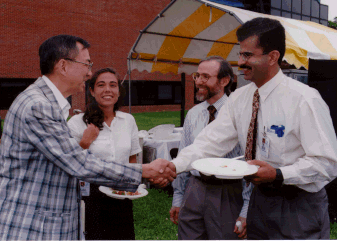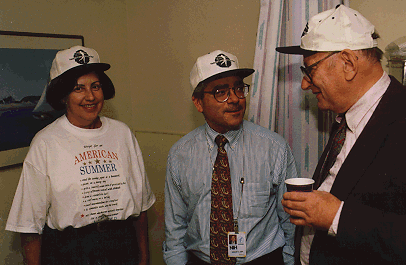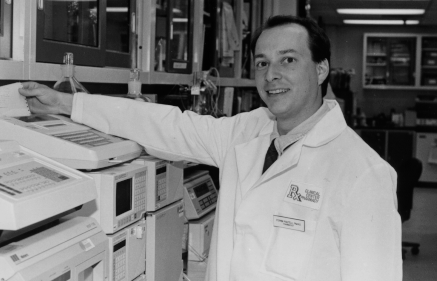
CC News: August 1996
In This Issue
Welcome
Epidemiologists modify protocol for occupational exposures to HIV
History of therapy traced
Hopkins, Suburban affiliation includes benefits for CC
CC study assesses herbal medicine use
briefs:
Living history brings historic battle to life
CC pharmacist receives award for outstanding research paper
Clinical Center News, Building 10, Room 1C255, National Institutes of Health, Bethesda, Maryland 20892. (301) 496-2563. Fax: 402-2984. Published monthly for CC employees by the Office of Clinical Center Communications, Colleen Henrichsen, chief. News, articles ideas, calendar events, letters, and photographs are welcome. Deadline for submission is the second Monday of each month.
Editor: Sara Byars sbyars@nih.gov
. Staff Writers: Laura Bradbard, Sue Kendall
|

Welcome
Nearly 100 physicians reported for duty at the Clinical Center last month
as clinical associates. Participants, who have completed residency or dental
programs before coming here, spend two or more years in subspecialty and
research training. Their first year typically is spent caring for the CC's
often unique patient population. Clinical research is the second year's
focus. On hand for a welcoming picnic were (from left) Dr. Philip Chen,
associate director of the Office of Intramural Affairs, NIH Office of Intramural
Research; Dr. Corina Gonzalez of Argentina; Dr. Michael Fordis, director
of the NIH Office of Education, and Dr. Nadir Ali Syed of New Jersey.
Return To CC News Contents
Epidemiologists modify protocol
for occupational exposures to HIV
Clinical Center epidemiologists have modified the protocol for treating
health-care workers accidentally exposed to HIV, the virus that causes AIDS.
"Our employees are our greatest resource," says Dr. David Henderson,
CC hospital epidemiologist and deputy director for clinical care. "We
are committed to preventing exposures to blood-borne pathogens and to thorough
management of these occupational injuries."
Accidental exposures are now treated with a combination of anti-retroviral
drugs that researchers say is literally hundreds of times more effective
against HIV than is zidovudine alone, the traditional therapy, Dr. Henderson
explains. "Researchers hope that the combination of drugs will be equally
as potent when used for post-exposure treatment." The CC's protocol
for occupational exposures is called post-exposure prophylaxis (PEP).
The new drug combination includes a drug commonly known as AZT, zidovudine,
(ZDV, a nucleoside analog); lamivudine, (3TC, also a nucleoside analog);
and the newest of approved anti-retrovirals, indinavir, (IND, a protease
inhibitor).
"Nucleoside analogs work by preventing HIV from making copies of itself,"
Dr. Henderson explains. "ZDV and 3TC given together have been shown
to substantially lower the number of circulating HIV particles. Together
they may reduce the chance of ZDV-resistant virus developing, which is a
danger in single-drug therapies. Indinavir prevents virus particles from
becoming mature and infectious. It appears to be among the most potent anti-HIV
agents discovered so far."
The new protocol follows on the heels of CDC recommendations issued in June.
"The CDC recommendation for routine, post-exposure drug therapy for
health-care workers accidentally exposed to HIV was in response to CDC's
review last fall of scientific evidence that suggested the post-exposure
treatment is effective."
CDC investigators presented findings of an important study, a retrospective
case-control study matching 31 health-care workers known to have acquired
HIV infection through occupational exposure with 697 uninfected control
health-care workers. The study identified five risk factors for developing
occupational infection:
- "Deep" injury;
- Visible blood on the device causing injury;
- That the device had been used in the source patient's vein or artery;
- The source patient died within 60 days of the exposure (an indirect
measure of how much virus was present in the patient); and
- The exposed health-care worker did not take ZDV.
"This study has limitations, but it provides the best available scientific
support for using antiretroviral agents for post-exposure treatment,"
Dr. Henderson says. "It induced CDC to modify their 1991 statement
regarding post-exposure prophylaxis and to outline the new recommendations."
Although the number of reported occupational HIV exposures in health-care
workers at the Clinical Center has decreased over the past eight years,
each injury is of concern. According to Dr. James Schmitt, medical director
of the Occupational Medical Service (OMS), NIH Division of Safety, 283 employee
injuries involving retroviruses, including HIV, were significant needle-stick
or cutting injuries; 85 were HIV-1 exposures.
The risk of becoming infected with HIV from an occupational injury involving
HIV-infected blood or body fluids is low, Dr. Schmitt points out. "Data
show only about three infections for every 1,000 needle-stick exposures
to blood from someone known to be infected with HIV. Even so, the risk for
occupational HIV infection remains a concern of health-care workers."
Primary prevention-using safe work practices on the job-is the best protection
against HIV exposures, says Dr. Schmitt. "Should an injury occur with
potentially HIV-infected material, immediately perform first aid and notify
your supervisor. Immediately report occupational exposures to OMS so evaluation
and treatment options are not delayed. Evidence suggests that treatment
should be started as soon as possible."
For treatment related to occupational injuries, call OMS at 496-4411. For
details on the PEP protocol, call Lucienne Nelson in the hospital epidemiology
service, 496-2209.
(by Lucienne Nelson, infection control specialist, Hospital Epidemiology Service)
Return To CC News Contents
History of therapy traced
Preventive therapies for accidental occupational exposures to HIV have evolved
as new strategies have proved effective.
Dr. David Henderson, CC epidemiologist and deputy director for clinical
care, and Dr. Jim Schmitt, medical director of the Occupational Medical
Service (OMS), NIH Division of Safety, have taken the lead here for nearly
10 years in providing post-exposure treatment to reduce the risk for infection
with HIV once an occupational exposure has occurred.
In 1988, the CC Medical Board, acting on the advice of Dr. Henderson and
Dr. Schmitt and the counsel of HIV experts from NCI and NIAID, elected to
offer the drug zidovudine (ZDV), commonly known as AZT, as post-exposure
treatment to CC health-care workers.
As this program gained momentum, Dr. Henderson teamed up with Dr. Julie
Gerberding, hospital epidemiologist at San Francisco General Hospital, to
develop a multi-center, open-label safety trial administering ZDV, a nucleoside
analog shown to be effective in treating patients infected with HIV, to
health-care workers after exposure to the virus.
San Francisco General independently had begun offering ZDV to exposed health-care
workers at about the same time as the CC, Dr. Henderson noted.
In 1991, a combination drug therapy was shown to be more effective, and
a second drug, didanosine (DDI), was added to the regime here. "There
was also evidence that some patients treated long-term with ZDV developed
a resistance to it," Dr. Henderson added.
NIAID and NICHD collaborated on a multi-center study in 1994, which demonstrated
that ZDV reduced transmission of virus from HIV-infected pregnant women
to their babies by about two-thirds.
"Although the mechanisms of mother-to-baby transmission are different
from those of occupational transmission," Dr. Henderson says, "the
study provided encouraging evidence that ZDV works to reduce the risks for
transmission in at least one setting."
'The latest refinement in the CC's post-exposure treatment reflects the
most recent recommendations from the CDC and PHS.
Return To CC News Contents
Hopkins, Suburban affiliation includes benefits for CC
A recently announced affiliation between Johns Hopkins Medicine and Suburban
Hospital will expand clinical practice and research opportunities for CC
staff physicians, clinical associates, and fellows.
The Hopkins-Suburban alliance is designed to foster exploration of new,
cooperative health-care ventures, including satellite outpatient clinics
in the Washington area.
"This venture opens up new training, clinical research, and patient-care
opportunities for CC and Hopkins physicians while strengthening the clinical
services available at Suburban Hospital," said Dr. John I. Gallin,
CC director, in announcing the Clinical Center's participation in the affiliation
agreement.
Under the agreement, CC clinicians will be able to practice at both Suburban
and Hopkins. CC clinical associates and fellows can do rotations with preceptors
at Hopkins and Suburban, and Hopkins residents will come here.
"This will allow Clinical Center patients valuable access to areas
of practice not currently available at the Clinical Center-areas such as
obstetrics and gynecology, orthopedic surgery and gastroenterology."
The collaboration will also allow he CC to expand research, referral, and
consulting relationships with physicians at Hopkins and Suburban, Dr. Gallin
added. "It is one example of several partnerships that the Clinical
Center is establishing as part of its outreach to the community. Rotation
options for clinical associates and Hopkins medical school residents will
enrich their educational experiences.
"This collaboration will increase our access to patients who may benefit
from participating in clinical research trials here at the Clinical Center.
It also gives us a chance to help students and community physicians learn
more about the clinical research process and how to participate in it."
Johns Hopkins Medicine includes the School of Medicine and Hopkins' two
hospitals. Suburban, in business for 50 years, is a 392-bed hospital across
Old Georgetown Road from NIH. It's the county's designated shock-trauma
center.
Return To CC News Contents
CC study assesses herbal medicine use
The popularity of herbal medicines is growing like a weed. Health products
made from plants are sold in health food and grocery stores for arthritis,
headaches, allergies, stress, and even the common cold.
A new Clinical Center Nursing Department study assessing the incidence of
herbal medicine use among some CC patients aims to illustrate what herbal
products are taken by CC patients, what percentage of patients use them,
and why.
The World Health Organization estimates that use of herbal medicines, also
called dietary supplements, is three to four times more common worldwide
than conventional biomedicine. These herb–based capsules, liquids, and
teas–products like ginseng, spirulina, camomile, milk thistle, ma huang,
and wheat grass–share drugstore shelf space with proven remedies like
vitamin C, calcium tablets, and antihistamines.
A New England Journal of Medicine study estimates one in three Americans
used some form of alternative medicine in 1990 to relieve chronic health
problems-and paid almost $14 billion for it.
Eunice Johnson, a CC nurse on the 9th floor clinic and primary investigator
of the study, surveyed 500 NIDDK, NICHD, and NIAMS outpatients being treated
for chronic hepatitis and hepatic, rheumatic, endocrine, or metabolic conditions.
"Chronically ill patients are vulnerable for herb use because their
medical needs are not being met. They have conditions for which there is
no cure," Johnson explains.
"We, as nurses, must consider a patient's cultural and emotional needs
and we need to create a research environment that is culturally sensitive
to these needs."
Subjects in Johnson's study completed an herbal assessment survey, which
gathered patient information such as their age, occupation, education, and
a description and cost of any herbal therapy they had used.
Johnson and her research team hope to create a database of potential effects
of herbal medicines and ultimately to seek answers to these questions:
- Are CC patients taking herbal medications?
- Are herbs affecting disease, health, or research?
- What do we need to know about the herbal products being used?
- What percent of CC patients use herbs?
- What problems could these herbs cause?
- Can we anticipate trends in herbal medicine use?
According to Johnson, herbal products have been associated with organ dysfunction
and unintentional overdose–sometimes leading to death. In one case reported
in the Washington Post, a 22-year-old Florida woman died because an herbal
tea she regularly drank robbed her body of potassium and other vital electrolytes
leading to sudden cardiac irregularities. Chapparal, an herbal product sold
as a cancer remedy, has caused liver damage, according to a 1992 FDA warning.
And Ma Huang, taken to suppress appetite, has been linked to 15 deaths.
Although all subjects enrolled in CC research protocols may voluntarily
disclose their herbal medicine use, the incidence and specific types of
herbs used are not known and have not been systematically assessed.
Safety is a concern with alternative therapies despite the popular misconception
that a "natural" therapy is without side effects. Herbal medicine
in the clinical research setting is of particular concern because these
products may affect interpretation of research results or pose safety concerns.
Some herbs may interact with prescribed medications, procedures, or laboratory
tests, and may interfere with the study results or place the patient at
risk for adverse effects.
"Concerns related to the toxicity of herbs–and their potential to
confound research results-warrant investigation of herb use in CC patients,"
Johnson explains. "The use of herbal therapies may or may not affect
health, may or may not affect the studies done here in the Clinical Center,
but herbal use is a component of treatment, which needs to be assesssed
and monitored."
(by Laura Bradbard)
Return To CC News Contents
briefs
New management for florist shop
The florist shop on the Clinical Center's first floor has reopened with
a cadre of CC Red Cross volunteers handling day-to-day operations and a
new subcontractor providing floral arrangements.
All proceeds from the enterprise benefit the Friends of the Clinical Center,
a program that helps CC patients and families with emergency financial needs
while they're patients here. The shop is administered by the NIH R&W.
Hours, which are expected to expand, initially will be weekdays, 10 a.m.-3
p.m.
Return To CC News Contents
Register now for
fall courses
The education and training section, Office of Human Resources Management,
will offer these courses in September:
- Practicing Safe Stress for the 1990s: Combat Strategies at the Burnout
Battle Front. Discover the four stages of burnout; overcome the Bjorn Bored
Syndrome; and practice "emancipation procrastination" and psychological
hardiness. Monday, Sept. 9, noon-3 p.m., or Tuesday, Sept. 10, 9 a.m.-noon,
6100 Executive Blvd, room 1 on the first floor. Parking and shuttle service
are available.
- Supervisory Discussion Program. This lunch-time discussion program allows
CC supervisors an opportunity to network, share information, exchange ideas,
and discuss issues and concerns. Friday, Sept. 27, noon-1 p.m., 2C310.
To register, call 496-1618.
Return To CC News Contents
Ethics discussion group planned
The CC Nursing Department in collaboration with the CC bioethics program
will host an interdisciplinary ethics discussion group on Aug. 16, 2-3 p.m.,
in the Medical Board Room. Discussions will center on dilemmas and responsibilities
concerning complementary and alternative medicine in a research setting.
Presenters are Sara Bergerson, Nutrition Department; Dr. Evan DeRenzo, senior
bioethics fellow; Andrew Sparber, Nursing Department; and Dr. Jeffery White,
NCI. All interested health-care professionals are invited.
Return To CC News Contents
Kitchen to move
The Nutrition Department's kitchen will temporarily move to the second floor
cafeteria kitchen in early fall to accommodate ceiling repairs.
That means that the 2nd floor cafeteria will close for the duration.
"The Nutrition Department's ceiling is old and defective," says
Ray Bowen, CC Building Services assistant chief. "It will be replaced
with a fiberglass composite that will be easier to clean and maintain."
Alberta Bourn, Nutrition Department chief, says, "This is a behind-the-scenes
operation that will have little-if any-impact on patients."
Cafeteria manager Ray Palmer says that although the 2nd floor cafeteria
will be closed, the B1 facility will have extra workers on duty in the kitchen
and on the cash registers.
Return To CC News Contents

Summer workers
More than 100 high school and college students are working with mentors
throughout labs and offices here this summer. They gathered for an orientation
reception in Lipsett Amphitheater last month. Among those welcoming the
group were Dr. David K. Henderson (second from left), CC deputy director
for clinical care, Walter L. Jones, CC deputy director for management and
operations, and Carl Lucas, CC special assistant, Office of Equal Opportunity.
Students attending the reception included (from left) Denise Leitner, Nursing
Department; Nikisha Smith, hematology section, Clinical Pathology; Michelle
Dorris, Critical Care Medicine; and Jay Wang, clinical chemistry service,
Clinical Pathology.
Return To CC News Contents

Survivors observance
NIH staff and CC patients gathered for a reception in the 12th floor clinic
June 27 in observance of National Cancer Survivors Day, a nationwide event
that spotlights the millions of Americans who are surviving cancer and leading
active, productive lives. Among those on hand for the event were (from left)
Linda Chatfield of Lanham, Maryland; Dr. Gregory Curt, NCI; and Marvin Kahn
of Rockville.
Return To CC News Contents

Drawing the winners
This year's savings bond campaign ended with a raffle for participants.
Conducting the drawing were (from left) Walter L. Jones, CC deputy director
for management and operations; Jack Patterson, campaign facilitator; Ann
Tyler, OD; and Randy Schools, R&W. CC's John Slovikosky received two
tickets for the Washington Bullets, donated by R&W; Sherman Ragland,
NIMH, was picked for a $25 R&W gift certificate, also donated by R&W.
The NIH Federal Credit Union donated a $100 savings bond, which went to
Ramona Millings, CC. Campaign canvassers and coordinators were eligible
for a $100 savings bond donated by Crestar. The winner was NCI's Barry Ryan.
Return To CC News Contents

Living history brings historic battles to life
Your ears ring. A stinking blast of burning black gunpowder stings your
face like hot salt as the battle lines grow closer. Three thousand men stand
rank and file. You fall face down, dead. Again.
Jim Minor dies a lot. As a Civil War re-enactor, he assumes the role of
a Confederate Army private, a front-line combatant who all too often is
killed or taken prisoner. The final outcome is always the same.
Several times a year, thousands of modern Americans dress in authentic period
clothing and march off to war. A few fight in the name of their ancestors.
Many more do what Minor did. He created a character to portray on the battlefield.
The CC pharmacist researched the Civil War history of his own hometown and
assumed the role of Charlie Gibson, the 17-year-old son of a haberdasher
from Reidsville, N.C.
"When you talk to observers after the re-enactment, you stay in character,
you keep your mind in the 1860s," Minor says. "Children may ask
what I watch on television. The answer is, 'What is television?' I love
to watch the surprise on their faces when I say that."
Getting ready to take part in a re-enactment isn't easy. The uniform, an
authentic reproduction, is handmade of wool and lined in heavy cotton. The
9-lb., .58 caliber Enfield musket, crafted in England, is identical to the
weapons used by the Confederate Army. Minor's glasses are actual Civil War
period frames carefully fitted with his present-day prescription. A tin
cup, leather belt, canvas haversack, bayonet scabbard, and rough leather
brogans complete the ensemble. Altogether, the uniform, weapons, and accessories
cost each participant over one thousand dollars.
"We are not a bunch of people who get together to hoot 'n' shoot,"
he explains. "Participants are well-educated students of Civil War
history. They aren't involved in order for the South to rise again. There
are no sides, really. Most men and women participate to share the history
of this important time in our nation's past with interested adults and especially
with children."
Re-enactment activities are well organized. Participants must attend the
"School for Soldiers," an annual, two-day formal field training
seminar, at their own expense. Both sides study Hardee's Manual for Infantry
Tactics, first published in 1860-mistakes and inaccuracies are not allowed.
Even the food they eat is chosen for the time period-dried bread, peanuts,
and fruit-items Charlie Gibson would have eaten.
Recordkeeping during the Civil War was amazingly accurate, Minor notes.
Re-enactments unfold almost exactly the way the real engagements took place,
usually occurring on the weekend closest to the actual battle date. Senior
officers from both sides meet the night before to plan the outcome. Minor
will be told if he lives or dies. He will know at which point in the hour-long
confrontation Charlie Gibson will fall or be taken prisoner.
"It's an emotional experience to go through. You are always aware that
this really happened with dire consequences," Minor adds.
During the first 30 minutes of most Civil War battles the casualty rate
averaged about 40 percent. It was the last war fought using Napoleonic tactics.
Soldiers advanced shoulder-to-shoulder for massed fire power. The weapons
of the time-cannons, muskets, and bayonets-created brutal injuries. Foot
soldiers often fought man against mounted-horse cavalry and in many instances,
the horse won.
The painstaking accuracy of the re-enactors paid off in 1992 when Ted Turner,
Turner Broadcasting media mogul, began production of his movie, "Gettysburg."
Turner put thousands of Civil War enthusiasts in his movie and at times
the re-enactors corrected inaccuracies in the scripted battle. Minor and
his 49th Virginia Infantry are veterans of that movie re-enactment.
History has always interested Minor, but his participation in re-enactments
resulted from a conversation five years ago with a Clinical Center patient
and artist from Clifton, Virginia. She shared Minor's love for antiques
and suggested he attend Clifton Days in Virginia. It was there that he witnessed
his first Civil War battle encampment. The rest, of course, is history.
Minor says it gets so hot standing in ranks-waiting for the artillery barrage
and the cavalry charges to end before his part, the infantry assault, begins-that
he usually loses about six pounds during each re-enactment.
"I got the worst sunburn in my life one day as I lay dead on the New
Market [Virginia] battlefield," he says. "I fell face up and had
to lay there for almost an hour in full sun."
After that experience, Minor learned how to survive the fall-drink large
volumes of water, wear hats with wider brims, and lie face down to avoid
the sun.
"Another time I just fell out. I was sick with heat prostration. So
I crawled under a captured cannon to get in the shade. A woman in period
costume came up to me with a basket of ice and handed me a few pieces to
rub on my head to cool off."
Soon, Minor, who holds a Ph.D. from the University of Southern California,
will leave the Clinical Center for a new job. He returns home to North Carolina
where he will join Glaxo Wellcome Company and Charlie Gibson will join the
26th N.C. Regiment.
"Fellow citizens, we cannot escape history."
Abraham Lincoln said it. Jim Minor lives it.
(-by Laura Bradbard)
Return To CC News Contents

CC pharmacist receives award
Dr. Stephen Piscitelli, director of the clinical pharmacokinetics research
lab in Pharmacy Department's pharmaceutical development section, has received
the 1996 McKeen Cattell Memorial Award given by the American College of
Clinical Pharmacology.
The award is given annually to the first author of the outstanding research
paper published by the Journal of Clinical Pharmacology.
His paper described the complex metabolism of phenylbutyrate, an investigational
anti-cancer drug, and how the body absorbs, distributes, and eliminates
the drug.
Dr. Piscitelli's research team used computer modeling to follow the path
of the drug and its two metabolites in patients receiving treatment for
advanced solid tumors.
Co-authors of the paper were Dr. Alain Thibault; Dr. William Figg; registered
nurses Anne Tompkins and Donna Headlee; Dr. Dvorit Samid; and Dr. Charles
Myers, NCI; and Dr. Ronald Lieberman, FDA.
Return To CC News Contents
Comments?
webmaster@cc.nih.gov
National Institutes of Health (NIH)
Warren Grant Magnuson Clinical Center (CC)
Bethesda, Maryland 20892
Last modified 8/19/96



